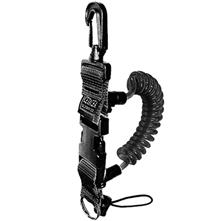My wife is looking at me funny as I drill into my new camera rig!!!
First off I put some HD female velcro down on the base the camera sits on. This lets the feet from the housing dig in a bit. Now I do not have to crank it down. After taking a few shot and taking the camera out for a charge. I found that the optical cable almost got stuck in the o-ring seal. It was going to close with the cable inside. I could see me doing this and flooding the unit. So I put two small holes in the base and ran the cable under the base and then back up another mounting hole. This really works well.
I did come up with a few questions that I have not yet found answers to in any of the books for the housing. Do you store the housing closed? Do you store the unit with the o-ring left in it? Do you remove it and store it inside the housing or ziploc? When you greese the o-ring do you do this every time you open up the unit? For example if I dive for two weeks do I remove and greese the o-ring once per week?
Thanks again for any information.
A few shots of my changes.
At first glance, I might also be tempted to look at you funny if I saw you taking a power drill to your new camera housing setup! However, it seems like the modifications you made really draw that optical cable away from the back hatch of the housing and get it out of the way in general - nice job.
I am in no way the foremost authority on underwater camera care, but I may be able to share some info with you. Hopefully some of those hardcore underwater photographers on this board will chime in and give us some advice.
As far as storing the housing open or closed, my housing came with a rubber piece that holds the back hatch just slightly open. I usually leave it like that (which puts NO pressure on the o-ring at all) and cover it with a towel, so no dust gets inside. I tend to dive almost every weekend, so my camera doesn't sit there for very long. As far as the o-ring goes, I've heard that one should have two sets og o-rings (one to store it and one to use it). I can see where the o-ring can be affected if you leave it closed and smashed too long, but I have not gone that route yet, and as I indicated, leave it slightly open, which doesn't affect the o-ring. I also don't think that you need to be overly obsessive about lubricating the o-ring. I think the key is to ensure that it is clean (free of any dust, lint, hairs, particles, salt, etc.) and that it is not dry. Under normal circumstances, the o-ring should not dry out overnight. I usually just make sure all the o-rings are clean (camera and strobe), and make sure the space where the o-rings sit are clean as well, then I moisten my fingers with the silicon the housing came with and just make sure the o-ring has the tiniest film of silicon and is not dry.
The bottom line is that if you are detailed and meticulous with your o-rings, then you will most likely avoid flooding your housing and camera. However, if you are not meticulous enough, you run the risk of flooding. I therefore feel you can't go wrong by being meticulous.
I've also heard that you should try to keep your camera soaking in fresh water after the dive, to ensure that the salt crystals don't dry on your o-rings. Rinse buckets on boats will help with that and will help with avoiding condensation inside the housing when you hit the water.
Hopefully someone more knowledgable will chime in and offer some helpful suggestions.
Adrian





















